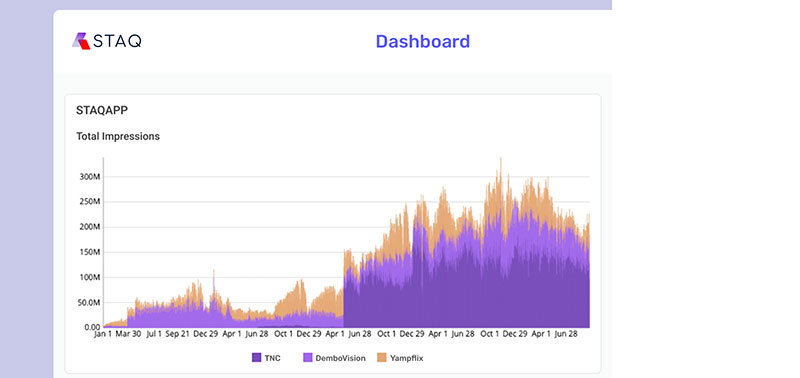Dave Dembowski from Operative talks about automating digital and linear ad revenue workflows to effectively reach audiences and deliver results that meet buyers’ expectations.

Effectively monetising video delivered on streaming and linear platforms is an ongoing challenge for media organisations. Monetisation involves not only deciding on the most productive approach for a particular service, but also managing and monitoring numerous complex processes that need to happen in close to real-time.
We had the opportunity to talk to Dave Dembowski, Senior Vice President of Global Sales at Operative, whose software is used in linear, streaming and converged advertising operations for video services. Their products are designed to automate digital and linear ad revenue workflows, in ways that reach audiences and deliver results that meet the expectations of buyers.
Complexity
According to Dave, the hardest part of monetizing streaming and multiplatform channels is the complexity of the process, from start to finish. “Streaming has elements of both linear and digital delivery, and buyers expect to be able to have it all," he said. "Broadcasters often want to sell their premium and live streaming ad inventory up front, much like a linear sale, and sell remaining longer-tail inventory programmatically – that is, automating inventory sales in real-time, using traffic data and online display targeting to make sure ads target the most suitable audiences.
“These two kinds of sales use different workflows, even if advertisers are the same and want a singular proposal, campaign and reporting experience. Delivering on streaming and multichannel campaigns can be as complicated as the sales process, where operations teams want to optimize performance but need to adhere to the rules of the contract, which may be quite complex, while maximizing revenue for their company.”

Centralised Ad Serving
Ad serving is a core function. All advertisements on a screen need to be ‘served’ - that is, they need to be scheduled and displayed on the screen. “How these ads are to be served is determined by insertion orders. Each insertion order is a contract or template that lists the details of an advertising deal between an advertiser and a channel – advertiser, the content itself and the targeting and pricing that is attached to it," said Dave.
“Service providers use different ad servers for linear, digital, video and streaming, but they all need to be told what to serve by some kind of central system – such as Operative software – that understands what advertisers have purchased, what the inventory availability is and how to maximize performance for buyers."
Without that central control, serving ads in such a way that meets the requirements of hundreds or even thousands of advertiser contracts, also connects to programmatic demand and optimizes performance, would be literally impossible. Millions of decisions and calculations need to be made for every single impression.
Formats, Platforms, Impressions
Dedicated ad serving support is, in fact, one of Operative's main services. With its experience, the company has gained expertise from training to implementation to ongoing ad serving management. It is a platform partner of Google Ad Manager 360 and delivers services and support to hundreds of companies.

Dave said, “A single broadcaster reaches millions of people across millions of impressions throughout the day. Hundreds of advertisers work with broadcasters at the national, regional and local level with specific placement requirements, pricing and targeting. The logic dictating which ad is shown to which person takes a huge number of data points into consideration.
“Furthermore, the proliferation of content distribution platforms, like streaming and FAST channels, has increased the variety of ad formats media companies need to manage. Each inventory type has a different set of buying, selling and measurement requirements that go along with it. To keep track of all of these factors in near-real time, in a way that optimally delivers for both advertisers and the media company itself, requires a specific set of tools.”
Monetisation Tools
Most of the products Operative develops and maintains involve automating advertising processes and data processing. For instance, Operative.One manages large-scale digital advertising sales and operations by serving as a central command centre that manages the complete ad order lifecycle from pre-sales planning for campaigns, to self-serve ad management, to order execution, reporting and billing. OnAir is a broadcast traffic management system that works across different channels, markets and media platforms. Users can target ad placement deliberately, avoiding waste and taking advantage of new revenue opportunities.
AOS collects data from all of a user’s ad platforms and data sources and uses AI to generate and give access to normalized, actionable data for targeting, planning and performance reporting. This functionality is useful to, for example, broadcast networks that want to converge sales across linear and digital properties, or companies that want to sell cross-platform packages within a single system.

“Operative's IBMS (integrated business management system) is its own platform of products that media companies use to connect data across linear and non-linear scheduling, aiming to increase the total long-run value of the content life cycle. For instance, content delivery methods such as CTV and OTT create enormous opportunities for engagement and personalisation, but at the same time greatly increase complexity for managing and utilising content rights.
“IBMS Content has the functionality that addresses those opportunities as well as the challenges. It has a single repository of assets, contracts and rights across all platforms, plus complete business management for the entire content lifecycle and compliance. Thus, over time, IBMS extracts the most value possible from content for media companies, while helping to increase sales revenue and efficiency.
Analytics for Informed Decisions and Strategy
One other essential part of a monetisation strategy is data-driven analytics. Especially when buying and selling programmatically, a company needs to understand its performance in terms of strategy, devices, geography and so on. Real-time monitoring is also important to follow changes in revenue, cost per 1,000 (CPM) and impressions across different dimensions. To make informed decisions and update strategies, reporting tools and industry benchmark data has to be made available as well.
Dave said, “Advertising data comes from many places and is notably different on linear vs. digital channels. Linear advertising is usually sold up front and based on GRPs (gross rating points or percentage of a target audience) while digital advertising is sold programmatically based on CPMs. Normalizing and comparing these two different data sets helps users better understand their entire business and make advantageous pricing, ad sales and delivery decisions, uncover revenue opportunities, and achieve better outcomes for advertisers.”

Operative has a product called STAQ that processes all of a media company’s advertising data, from any source, producing a unified view of their performance in real time. STAQ also gives detailed insights into overall industry trends in demand, pricing, channel growth and so on, resulting in competitive intelligence a media organisation can use to compare their own business to the wider marketplace.
Interoperability
The fact that Operative’s applications are designed to integrate with many existing media industry ad revenue platforms and data sources – Imagine Communications, AWS, Salesforce, others – differentiates the company.
“Our software operates as the connective tissue that unifies all of the complex elements of revenue management, advertising and content delivery. From that unification, our tools can speed sales, automate processes and, ultimately, simplify management of a complete advertising workflow,” Dave said. Operative’s APIs establish connections between platforms and, as cloud-based software, the flexible, interoperable nature of the tools themselves makes them relatively easy to integrate. www.operative.com




















